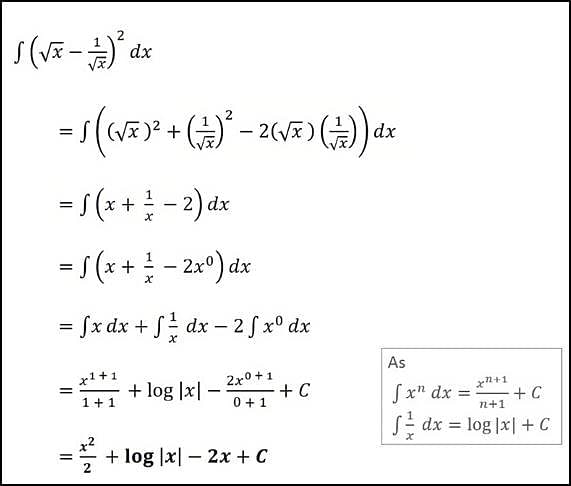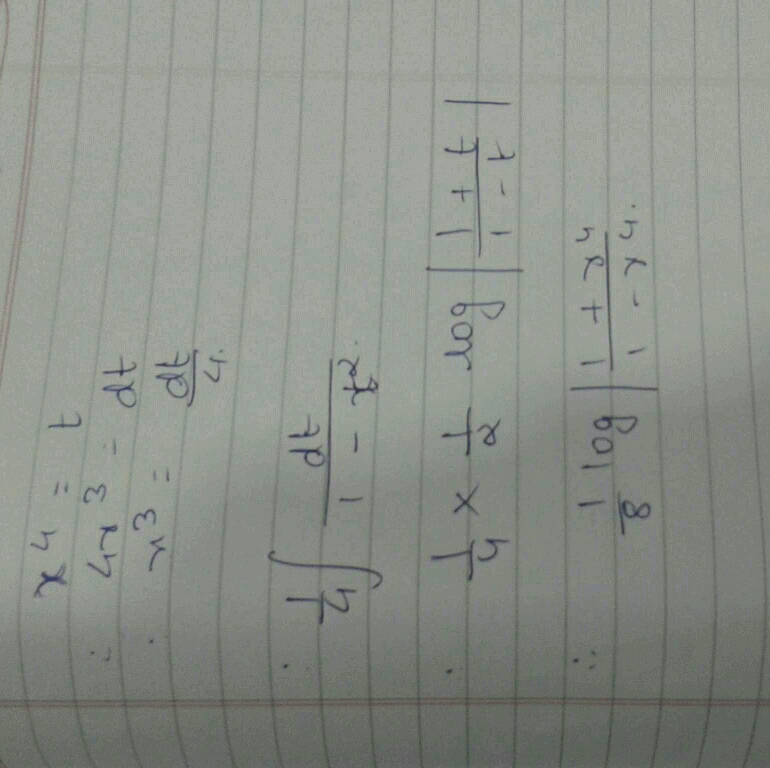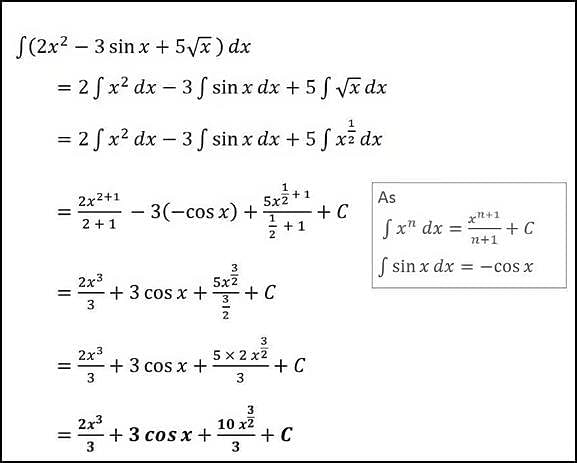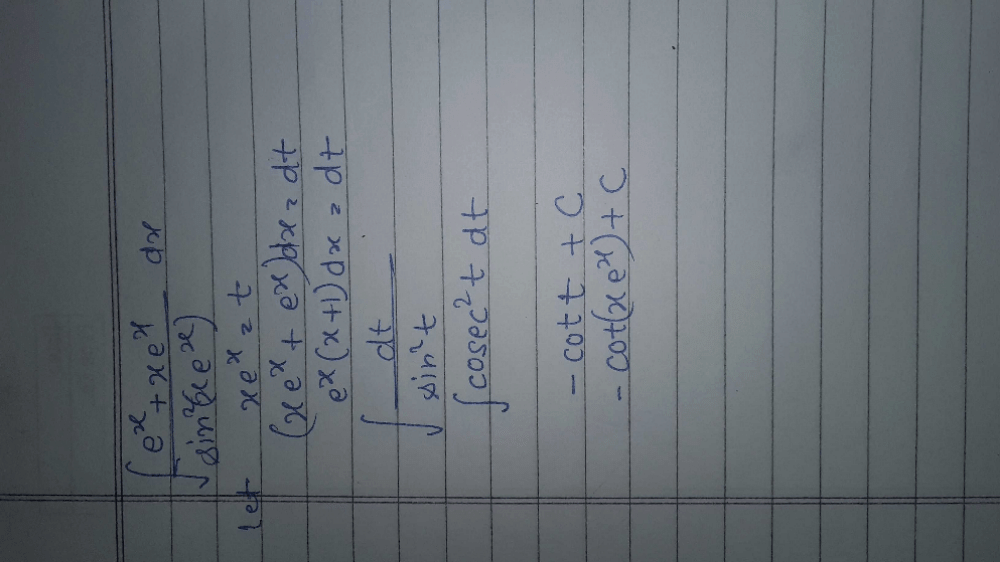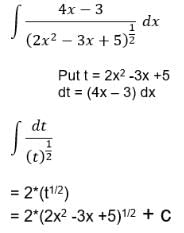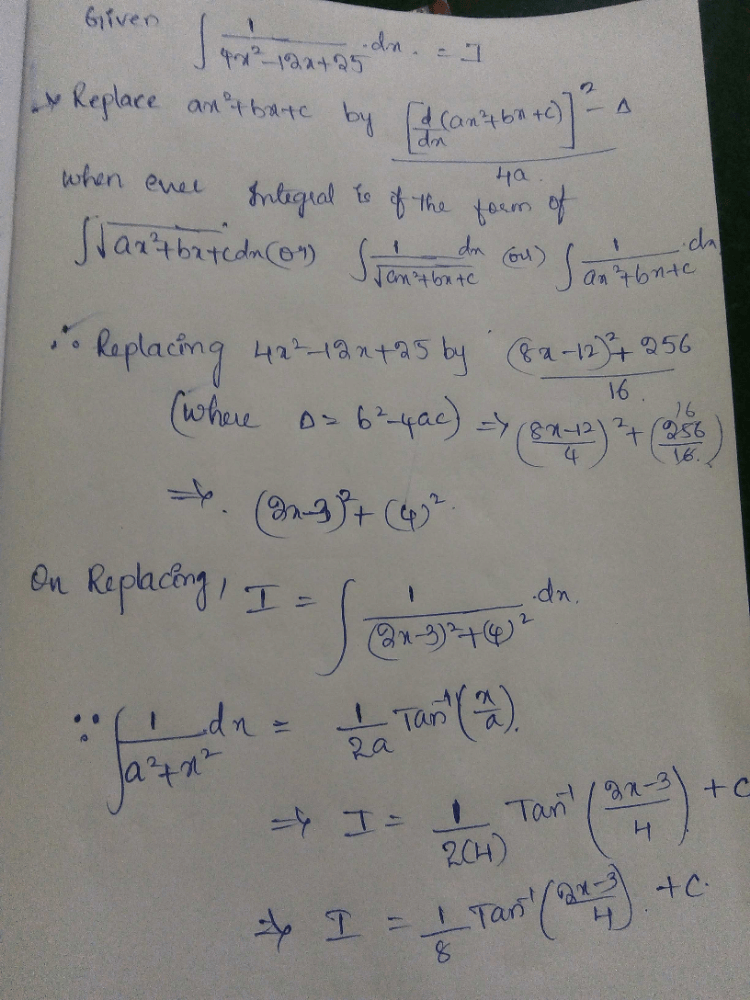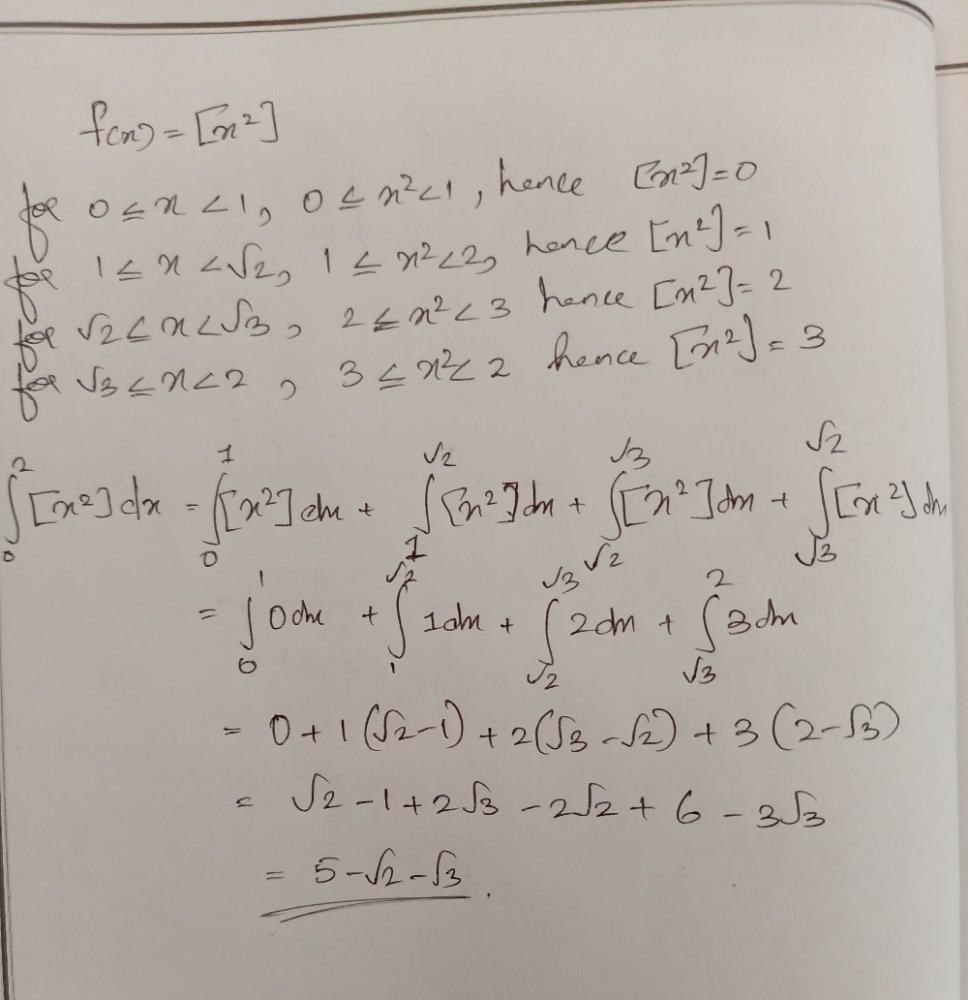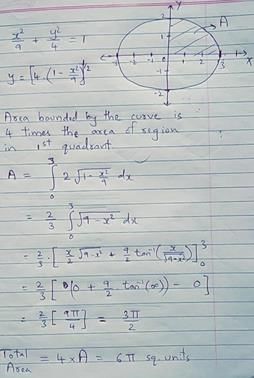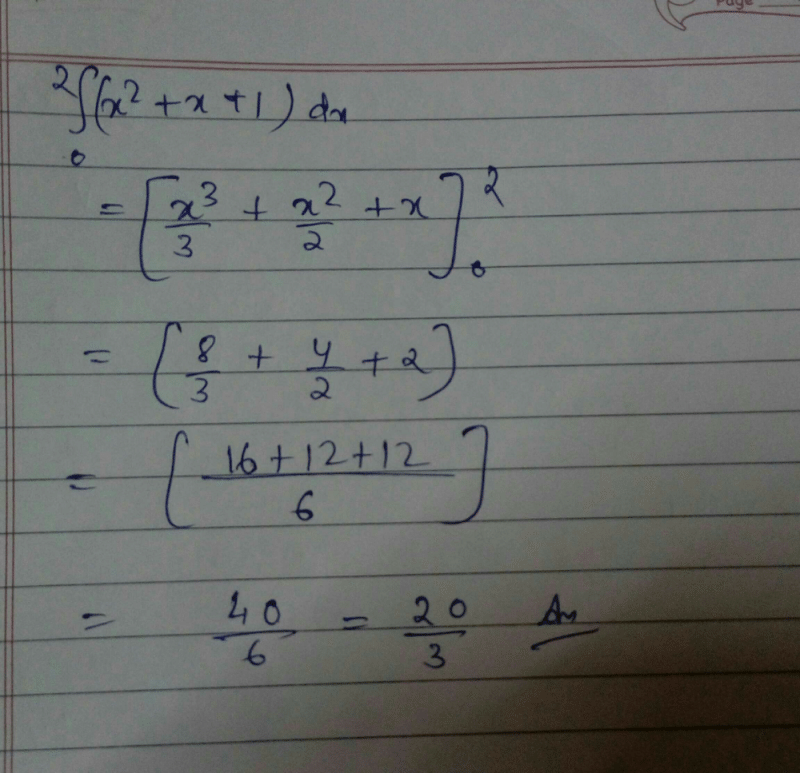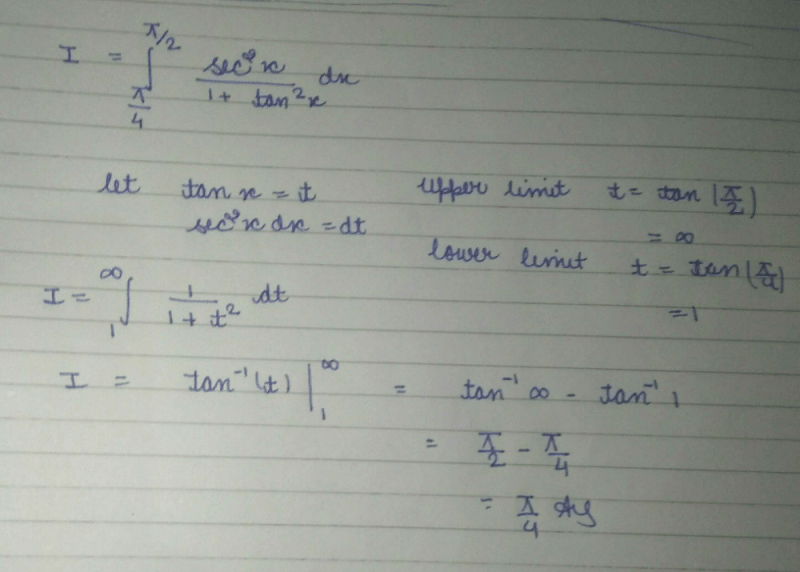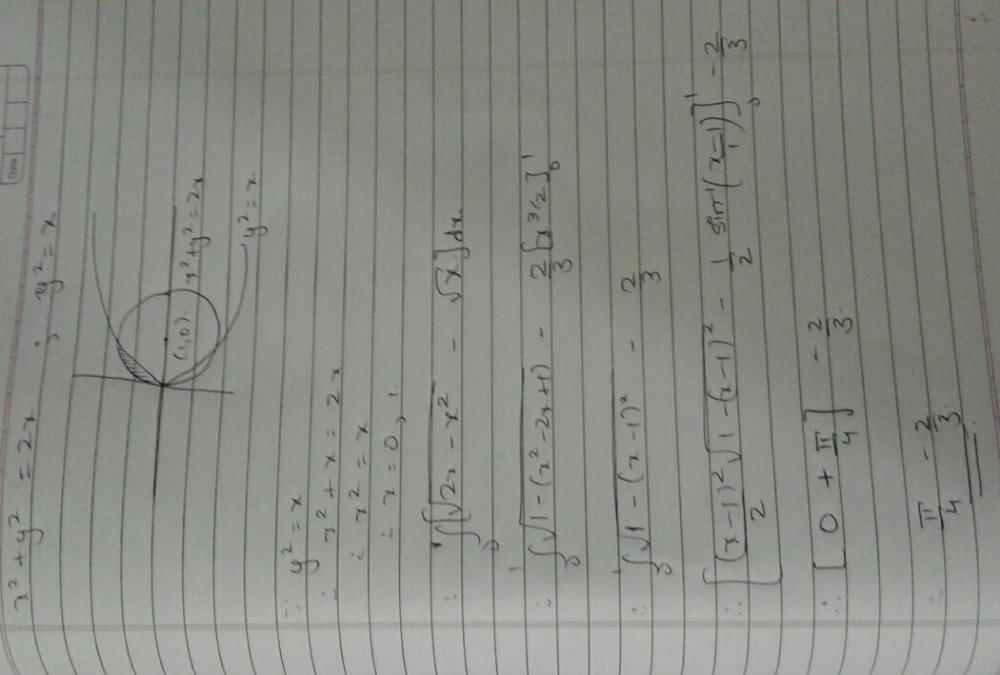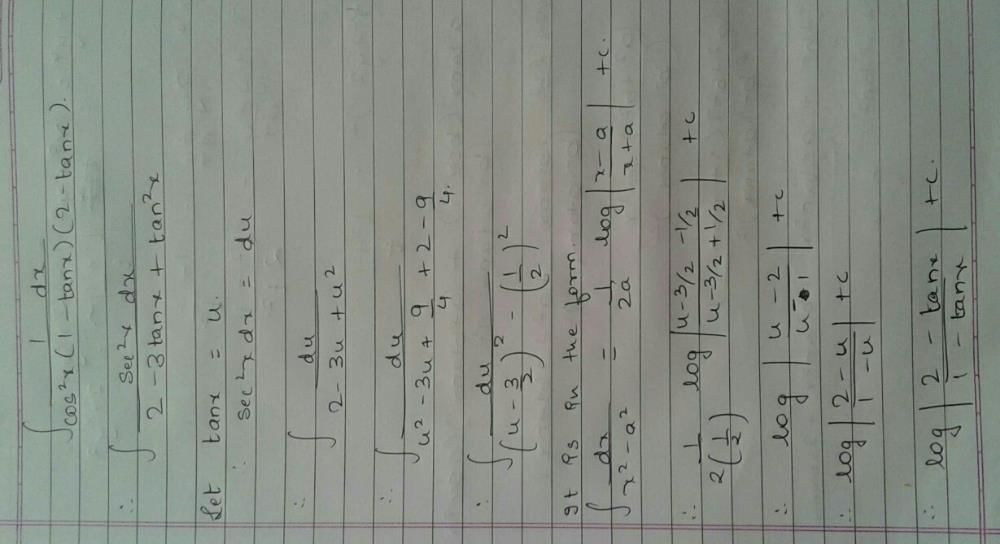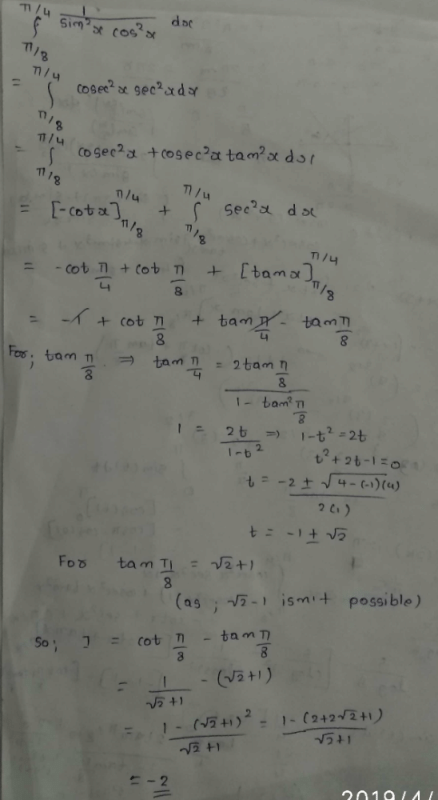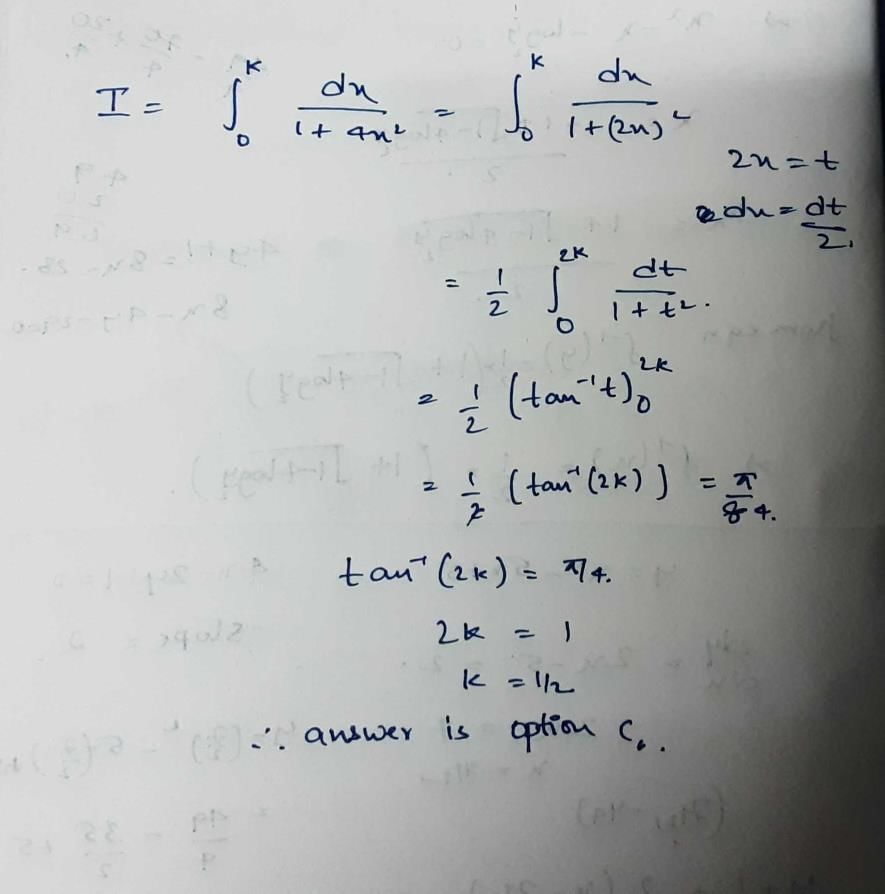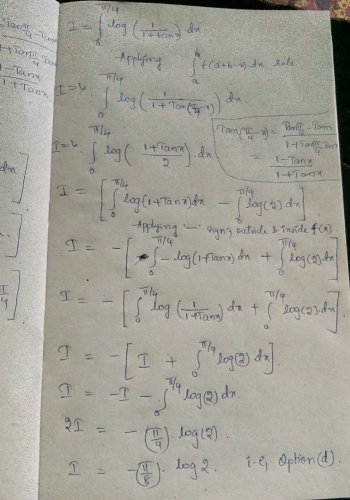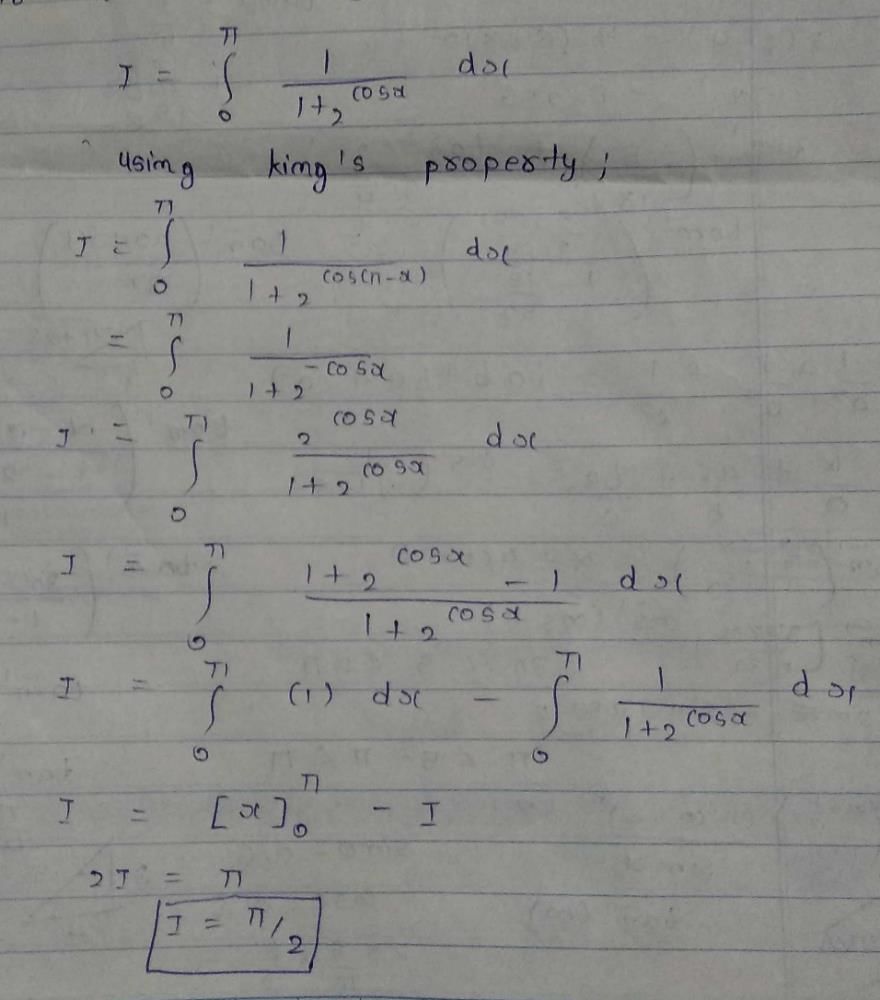All Exams >
Commerce >
Applied Mathematics for Class 12 >
All Questions
All questions of Integration and its Applications for Commerce Exam

- a)cos(sin-1x) + c
- b)sin-1x + c
- c)sin(cos-1x) + c
- d)x + c
Correct answer is option 'D'. Can you explain this answer?
a)
cos(sin-1x) + c
b)
sin-1x + c
c)
sin(cos-1x) + c
d)
x + c

|
Divey Sethi answered |
cos(sin-1x)/(1-x2)½……………….(1)
t = sin-1 x
dt = dx/(1-x2)½
Put the value of dt in eq(1)
= ∫cost dt
= sint + c
= sin(sin-1 x) + c
⇒ x + c
t = sin-1 x
dt = dx/(1-x2)½
Put the value of dt in eq(1)
= ∫cost dt
= sint + c
= sin(sin-1 x) + c
⇒ x + c
Integral of sin5x.cos2x is: - a)

- b)

- c)

- d)

Correct answer is 'A'. Can you explain this answer?
Integral of sin5x.cos2x is:
a)
b)
c)
d)

|
Learners Habitat answered |
So Looking at this integral, we have






Evaluate: 
- a)

- b)

- c)

- d)

Correct answer is option 'D'. Can you explain this answer?
Evaluate: 
a)
b)
c)
d)
|
|
Leelu Bhai answered |
I = ∫√(x² + 5x)dx= ∫√(x² + 5x + 25/4 - 25/4)= ∫√{(x + 5/2)² - (5/2)²}={1/2(x+5/2)(√x² + 5x)} - {25/8 log{(x + 5/2)+√x²+ 5x}}= {(2x + 5)/4 (√x² + 5x)} - {25/8 log{(x + 5/2)+√x²+ 5x}}Thus, option D is correct...
Evaluate: 
- a)

- b)1/√3 arc tan[(x-2)/√5] + C
- c)

- d)
%7D%7D%7D%2B%7BC%7D)
Correct answer is option 'D'. Can you explain this answer?
Evaluate: 

a)
b)
1/√3 arc tan[(x-2)/√5] + C
c)
d)
|
|
Deepak Kapoor answered |
Let's apply the integral substitution,
substitute 
Now use the standard integral :}}})
substitute back u=(x-2) and add a constant C to the solution,

- a)
 , where C is a constant
, where C is a constant - b)
 , where C is a constant
, where C is a constant - c)
 , where C is a constant
, where C is a constant - d)
 , where C is a constant
, where C is a constant
Correct answer is option 'C'. Can you explain this answer?
a)
b)
c)
d)

|
Divey Sethi answered |
q = √x, dq = dx/2√x
⇒ dx = 2q dq
so the integral is 2∫qcosqdq
integration by parts using form
∫uv' = uv − ∫u'v
here u = q, u'= 1 and v'= cosq, v=sinq
so we have 2(qsinq −∫sinqdq)
= 2(qsinq + cosq + C)
= 2(√xsin√x + cos√x + C)
⇒ dx = 2q dq
so the integral is 2∫qcosqdq
integration by parts using form
∫uv' = uv − ∫u'v
here u = q, u'= 1 and v'= cosq, v=sinq
so we have 2(qsinq −∫sinqdq)
= 2(qsinq + cosq + C)
= 2(√xsin√x + cos√x + C)
The area shaded in the given figure can be calculated by which of the following definite integral?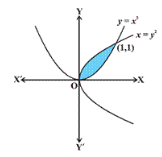
- a)

- b)

- c)

- d)

Correct answer is option 'D'. Can you explain this answer?
The area shaded in the given figure can be calculated by which of the following definite integral?
a)
b)
c)
d)
|
|
Leelu Bhai answered |
The required area is calculated by the difference ... moreof area of upper curve and lower curve.Now equation of upper curve
Evaluate: 
- a)

- b)

- c)

- d)

Correct answer is option 'A'. Can you explain this answer?
Evaluate: 
a)
b)
c)
d)
|
|
Krishna Iyer answered |
∫dx/x(xn + 1)..............(1)
∫dx/x(xn + 1) *(xn - 1)/(xn - 1)
Put xn = t
dt = nx(n-1)dx
dt/n = x(n-1)dx
Put the value of dt/n in eq(1)
= ∫(1/n)dt/t(t+1)
= 1/n ∫dt/(t+1)t
= 1/n{∫dt/t - ∫dt/t+1}
= 1/n {ln t - lnt + 1} + c
= 1/n {ln |t/(t + 1)|} + c
= 1/n {ln |xn/(xn + 1)|} + c
∫dx/x(xn + 1) *(xn - 1)/(xn - 1)
Put xn = t
dt = nx(n-1)dx
dt/n = x(n-1)dx
Put the value of dt/n in eq(1)
= ∫(1/n)dt/t(t+1)
= 1/n ∫dt/(t+1)t
= 1/n{∫dt/t - ∫dt/t+1}
= 1/n {ln t - lnt + 1} + c
= 1/n {ln |t/(t + 1)|} + c
= 1/n {ln |xn/(xn + 1)|} + c
Evaluate: 
- a)1/2
- b)1/4
- c)1
- d)1/8
Correct answer is option 'B'. Can you explain this answer?
Evaluate: 
a)
1/2
b)
1/4
c)
1
d)
1/8

|
Sumair Sadiq answered |
This is maths questions I can explain it but you know it is not possible here because this app is not allow to take photo but try it ok let tan inverce 4x =t diff both side wrt x 4x³/1+x⁴ Ka square
x cube / 1+ x8 =dt/4 I = £ 0 se pie by 2 (because when x= 0 t = pie by 2and x = infinity then t = 0 )
I = 1/4 £ 0 se pie by 2 sin t l = 1/4 (- cos t limit 0 se pie by 2 )l = 1/4 ( - cos pie by 2 + cos 0) l = 1/4 ( 0+ 1) l= 1/4 × 1l= 1/4
use my WhatsApp number for further questions but only for study 7060398771
x cube / 1+ x8 =dt/4 I = £ 0 se pie by 2 (because when x= 0 t = pie by 2and x = infinity then t = 0 )
I = 1/4 £ 0 se pie by 2 sin t l = 1/4 (- cos t limit 0 se pie by 2 )l = 1/4 ( - cos pie by 2 + cos 0) l = 1/4 ( 0+ 1) l= 1/4 × 1l= 1/4
use my WhatsApp number for further questions but only for study 7060398771
Evaluate: 
- a)

- b)

- c)

- d)

Correct answer is option 'A'. Can you explain this answer?
Evaluate: 
a)
b)
c)
d)
|
|
Preeti Iyer answered |
(x)½ (a - x)½ dx
= ∫(ax - x2)½ dx
= ∫{-(x2 - ax)½} dx
= ∫{-(x2 - ax + a2/4 - a2/4)½} dx
= ∫{-(x - a/2)2 - a2/4} dx
= ∫{(a/2)2 - (x - a/2)2} dx
= ½(x - a/2) {(a/2)2 - (x - a/2)2} + (a2/4) (½ sin-1(x - a)/a2)
= {(2x - a)/4 (ax - x2)½} + {a2/8 sin-1(2x - a)/a} + c
= ∫(ax - x2)½ dx
= ∫{-(x2 - ax)½} dx
= ∫{-(x2 - ax + a2/4 - a2/4)½} dx
= ∫{-(x - a/2)2 - a2/4} dx
= ∫{(a/2)2 - (x - a/2)2} dx
= ½(x - a/2) {(a/2)2 - (x - a/2)2} + (a2/4) (½ sin-1(x - a)/a2)
= {(2x - a)/4 (ax - x2)½} + {a2/8 sin-1(2x - a)/a} + c
The integration of the function ex.cos3x is:- a)

- b)

- c)

- d)

Correct answer is option 'D'. Can you explain this answer?
The integration of the function ex.cos3x is:
a)
b)
c)
d)
|
|
Om Desai answered |
Let I = ∫ex . cos 3x dx
⇒ I = cos 3x × ∫ex dx − ∫[d/dx(cos 3x) × ∫ex dx]dx
⇒ I = ex cos 3x − ∫(− 3 sin 3x . ex)dx
⇒ I = ex cos 3x + 3∫sin 3x . ex dx
⇒ I = ex cos 3x + 3[sin 3x × ∫ex dx − ∫{ddx(sin 3x) × ∫ex dx}dx]
⇒ I = ex cos 3x + 3[sin 3x . ex − ∫3 cos 3x . ex dx]
⇒ I = ex cos 3x + 3 ex . sin 3x − 9∫ex . cos 3x dx
⇒ I = ex cos 3x + 3 ex . sin 3x − 9I
⇒ 10I = ex cos 3x + 3 ex . sin 3x
⇒ I = 1/10[ex cos 3x + 3 ex . sin 3x] + C
⇒ I = cos 3x × ∫ex dx − ∫[d/dx(cos 3x) × ∫ex dx]dx
⇒ I = ex cos 3x − ∫(− 3 sin 3x . ex)dx
⇒ I = ex cos 3x + 3∫sin 3x . ex dx
⇒ I = ex cos 3x + 3[sin 3x × ∫ex dx − ∫{ddx(sin 3x) × ∫ex dx}dx]
⇒ I = ex cos 3x + 3[sin 3x . ex − ∫3 cos 3x . ex dx]
⇒ I = ex cos 3x + 3 ex . sin 3x − 9∫ex . cos 3x dx
⇒ I = ex cos 3x + 3 ex . sin 3x − 9I
⇒ 10I = ex cos 3x + 3 ex . sin 3x
⇒ I = 1/10[ex cos 3x + 3 ex . sin 3x] + C
The area between the curves y = x2 and y = x3 is:
- a) 1/12 sq.units
- b) 1/8 sq.units
- c) 1/10 sq.unit
- d) 1/6 sq.units
Correct answer is option 'A'. Can you explain this answer?
The area between the curves y = x2 and y = x3 is:
a)
1/12 sq.unitsb)
1/8 sq.unitsc)
1/10 sq.unitd)
1/6 sq.units|
|
Arun Khanna answered |
First we note that the curves intersect at the points (0,0) and (1,1). Then we see that
x^3 < x^2
in this interval. Hence the area is given by

= 1/3 - 1/4 = 1/12.

- a)-1
- b)zero
- c)1
- d)2
Correct answer is option 'B'. Can you explain this answer?
a)
-1
b)
zero
c)
1
d)
2

|
Praveen Kumar answered |
∫(0 to 4)(x)1/2 - x2 dx
= [[(x)3/2]/(3/2) - x2](0 to 4)
= [[2x3/2]/3 - x2](0 to 4)
= [[2(0)3/2]/3 - (0)2]] - [[2(4)3/2]/3 - (4)2]]
= 0-0
= 0
= [[(x)3/2]/(3/2) - x2](0 to 4)
= [[2x3/2]/3 - x2](0 to 4)
= [[2(0)3/2]/3 - (0)2]] - [[2(4)3/2]/3 - (4)2]]
= 0-0
= 0
The value of the integral  is:
is:- a)2e – 1
- b)2e + 1
- c)2e
- d)2(e – 1)
Correct answer is option 'D'. Can you explain this answer?
The value of the integral  is:
is:
a)
2e – 1
b)
2e + 1
c)
2e
d)
2(e – 1)

|
Infinity Academy answered |
Correct Answer : d
Explanation : ∫(-1 to 1) e|x| dx
∫(-1 to 0) e|x|dx + ∫(0 to 1) e|x|dx
e1 -1 + e1 - 1
=> 2(e - 1)
Evaluate: 
- a)

- b)

- c)

- d)

Correct answer is option 'D'. Can you explain this answer?
Evaluate: 
a)
b)
c)
d)
|
|
Vikas Kapoor answered |
I=∫sin(logx)×1dx
= sin(logx) × x−∫cos(logx) × (1/x)×xdx
= xsin(logx)−∫cos(logx) × 1dx
= xsin(logx)−[cos(logx) × x−∫sin(logx) × (1/x) × xdx]
∴ I=xsin(logx)−cos(logx) × x−∫sin(logx)dx
2I=x[sin(logx)−cos(logx)]
∴ I=(x/2)[sin(logx)−cos(logx)]
= sin(logx) × x−∫cos(logx) × (1/x)×xdx
= xsin(logx)−∫cos(logx) × 1dx
= xsin(logx)−[cos(logx) × x−∫sin(logx) × (1/x) × xdx]
∴ I=xsin(logx)−cos(logx) × x−∫sin(logx)dx
2I=x[sin(logx)−cos(logx)]
∴ I=(x/2)[sin(logx)−cos(logx)]
If  is
is- a)2/3
- b)4/5
- c)1
- d)None of these
Correct answer is option 'B'. Can you explain this answer?
If  is
is
a)
2/3
b)
4/5
c)
1
d)
None of these

|
Arjun Singh answered |
F'(x)=log(1+x^-2) then differentiate it one time to get f''(x)
Integrate 
- a)3x – 4 log |sec x| + tan x + C
- b)3x + 4 log |sec x| + tan x
- c)3x + 4 log |sec X| + tan x + C
- d)3x + 4 log |sec x| – tan x + C
Correct answer is option 'C'. Can you explain this answer?
Integrate 
a)
3x – 4 log |sec x| + tan x + C
b)
3x + 4 log |sec x| + tan x
c)
3x + 4 log |sec X| + tan x + C
d)
3x + 4 log |sec x| – tan x + C
|
|
Vikas Kapoor answered |
∫(2+tan x)2dx
= ∫(4 + tan2 x + 4tan x)dx
= ∫4 dx + ∫tan2 x dx + 4∫tan x dx
= 4x + ∫(sec2 x - 1)dx + 4(log|sec x|)
= 4x + tanx - x + 4(log|sec x|)
3x + tanx + 4(log|sec x|) + c
= ∫(4 + tan2 x + 4tan x)dx
= ∫4 dx + ∫tan2 x dx + 4∫tan x dx
= 4x + ∫(sec2 x - 1)dx + 4(log|sec x|)
= 4x + tanx - x + 4(log|sec x|)
3x + tanx + 4(log|sec x|) + c
The area of the region bounded by y = x2 – 2x and y = 4 – x2 is.- a)7 sq. units
- b)8 sq. units
- c)9 sq. units
- d)10 sq. units
Correct answer is option 'C'. Can you explain this answer?
The area of the region bounded by y = x2 – 2x and y = 4 – x2 is.
a)
7 sq. units
b)
8 sq. units
c)
9 sq. units
d)
10 sq. units
|
|
Vikas Kapoor answered |
To find area between y = x2 – 2x and y = 4 – x2,
We need to find POI.
x2 – 2x = 4 – x2
2x2 - 2x – 4 = 0
x2 – x – 2 = 0
(x-2)(x+1) = 0
x = -1, 2


= [(-2x3)/3 + x2 + 4x]x=2 - [(-2x3)/3 + x2 + 4x]x= -1
= -16/3 + 4 + 8 – (2/3 + 1 - 4)
= 9 sq units
We need to find POI.
x2 – 2x = 4 – x2
2x2 - 2x – 4 = 0
x2 – x – 2 = 0
(x-2)(x+1) = 0
x = -1, 2


= [(-2x3)/3 + x2 + 4x]x=2 - [(-2x3)/3 + x2 + 4x]x= -1
= -16/3 + 4 + 8 – (2/3 + 1 - 4)
= 9 sq units

- a)

- b)

- c)

- d)

Correct answer is option 'D'. Can you explain this answer?
a)
b)
c)
d)
|
|
Vikas Kapoor answered |
Option d is correct, because it is the property of definite integral
∫02a f(x) dx = ∫0a f(x) dx + ∫0a f(2a – x) dx
∫02a f(x) dx = ∫0a f(x) dx + ∫0a f(2a – x) dx
Find 
- a)π/4
- b)π/2
- c)4π
- d)2π
Correct answer is option 'B'. Can you explain this answer?
Find 
a)
π/4
b)
π/2
c)
4π
d)
2π
|
|
Vivek Patel answered |
Using trigonometric identities, we have
cos2x=cos2x-sin2x -(1) and cos2x+sin2x =1 -(2)
cos2x=1-sin2x , substituting this in equation (1) we get
cos2x=1-sin2x-sin2x=1-2sin2x
So,cos2x=1-2sin2x
2sin2x=1-cos2x

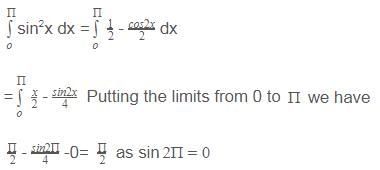
cos2x=cos2x-sin2x -(1) and cos2x+sin2x =1 -(2)
cos2x=1-sin2x , substituting this in equation (1) we get
cos2x=1-sin2x-sin2x=1-2sin2x
So,cos2x=1-2sin2x
2sin2x=1-cos2x


The area enclosed between the lines x = 2 and x = 7 is- a)Infinite
- b)7 units
- c)5 units
- d)2 units
Correct answer is option 'A'. Can you explain this answer?
The area enclosed between the lines x = 2 and x = 7 is
a)
Infinite
b)
7 units
c)
5 units
d)
2 units
|
|
Manas Khantal answered |
See from graph of x=2 & x=7 it's simple

- a)π
- b)π/2
- c)2π
- d)π/4
Correct answer is option 'B'. Can you explain this answer?
a)
π
b)
π/2
c)
2π
d)
π/4

|
Tarun Kaushik answered |
For sin2(X), we will use the cos double angle formula:
cos(2X) = 1 - 2sin2(X)
The above formula can be rearranged to make sin2(X) the subject:
sin2(X) = 1/2(1 - cos(2X))
You can now rewrite the integration:
∫sin2(X)dX = ∫1/2(1 - cos(2X))dX
Because 1/2 is a constant, we can remove it from the integration to make the calculation simpler. We are now integrating:
1/2 x ∫(1 - cos(2X)) dX
= 1/2 x (X - 1/2sin(2X)) + C]-pi/4 to pi/4
∫sin2(X) dX = [1/2X - 1/4sin(2X)]-pi/4 to pi/4 + C
½[-pi/2] - 1/4sin(2(-pi/4)] - ½[pi/2] - 1/4sin(2(pi/4)]
= π/2
cos(2X) = 1 - 2sin2(X)
The above formula can be rearranged to make sin2(X) the subject:
sin2(X) = 1/2(1 - cos(2X))
You can now rewrite the integration:
∫sin2(X)dX = ∫1/2(1 - cos(2X))dX
Because 1/2 is a constant, we can remove it from the integration to make the calculation simpler. We are now integrating:
1/2 x ∫(1 - cos(2X)) dX
= 1/2 x (X - 1/2sin(2X)) + C]-pi/4 to pi/4
∫sin2(X) dX = [1/2X - 1/4sin(2X)]-pi/4 to pi/4 + C
½[-pi/2] - 1/4sin(2(-pi/4)] - ½[pi/2] - 1/4sin(2(pi/4)]
= π/2
The curves x2 + y2=16 and y2 = 6x intersects at- a)(0, 2√3)
- b)(0, 2)
- c)(2, 2√3)
- d)(2, 0)
Correct answer is option 'C'. Can you explain this answer?
The curves x2 + y2=16 and y2 = 6x intersects at
a)
(0, 2√3)
b)
(0, 2)
c)
(2, 2√3)
d)
(2, 0)

|
Sushil Kumar answered |
x2 + y2=16 and y2 = 6x
So, to figure out the P.O.I
x2 + 6x = 16
x2 + 6x – 16 = 0
(x+8) (x-2) = 0
x = -8, 2
For x = -8
y = (6*(-8))1/2
= (-48)1/2
No real value for y
For x = 2
y = (6*2)1/2
= (12)1/2
= 2*(3)1/2
So, P.O.I is (2 , 2*(3)1/2 )
So, to figure out the P.O.I
x2 + 6x = 16
x2 + 6x – 16 = 0
(x+8) (x-2) = 0
x = -8, 2
For x = -8
y = (6*(-8))1/2
= (-48)1/2
No real value for y
For x = 2
y = (6*2)1/2
= (12)1/2
= 2*(3)1/2
So, P.O.I is (2 , 2*(3)1/2 )

- a)if f(2a – x) = – f(x)
- b)if f(2a – x) = f(x)
- c)if f(- x) = f(x)
- d)if f(- x) = – f(x)
Correct answer is option 'D'. Can you explain this answer?
a)
if f(2a – x) = – f(x)
b)
if f(2a – x) = f(x)
c)
if f(- x) = f(x)
d)
if f(- x) = – f(x)
|
|
Om Desai answered |
∫(-a to a)f(x)dx
= ∫(0 to a) [f(x) + f(-x)] if f(x) is an odd function
⇒ f(-x) = -f(x)
= ∫(0 to a) [f(x) + f(-x)] if f(x) is an odd function
⇒ f(-x) = -f(x)
Evaluate: 
- a)

- b)

- c)

- d)

Correct answer is option 'B'. Can you explain this answer?
Evaluate: 
a)
b)
c)
d)
|
|
Om Desai answered |
sin2x = 1 - cos2x
∫sinx(sin2x - 3cos2x + 15)dx
Put cos2x = t
∫sinx(1 - cos2x - 3cos2x + 15)dx
= ∫sinx (16 - 4cos2x)dx
Put t = cosx, differentiate with respect to x, we get
dt/dx = -sinx
= - ∫ [(16 - 4t2)]1/2dt
= -2 ∫ [(2)2 - (t)2]½
= -2{[(2)2 - (t)2]½ + 2sin-1(t/2)} + c
= - cosx {[4 - (cos)2x]½ - 4sin-1(cosx/2)} + c
∫sinx(sin2x - 3cos2x + 15)dx
Put cos2x = t
∫sinx(1 - cos2x - 3cos2x + 15)dx
= ∫sinx (16 - 4cos2x)dx
Put t = cosx, differentiate with respect to x, we get
dt/dx = -sinx
= - ∫ [(16 - 4t2)]1/2dt
= -2 ∫ [(2)2 - (t)2]½
= -2{[(2)2 - (t)2]½ + 2sin-1(t/2)} + c
= - cosx {[4 - (cos)2x]½ - 4sin-1(cosx/2)} + c
Evaluate: 
- a)(x + b) cos(a – b) – sin(a – b).log | sin(x + b) | + C
- b)(x + b) cos(b – a) – sin(b – a).log | sin(x + b) | + C
- c)(x + b) cos(b – a) + sin(b – a).log | sin(x + b) | + C
- d)(x + b) cos(a – b) + sin(a – b).log | sin(x + b) | + C
Correct answer is option 'D'. Can you explain this answer?
Evaluate: 
a)
(x + b) cos(a – b) – sin(a – b).log | sin(x + b) | + C
b)
(x + b) cos(b – a) – sin(b – a).log | sin(x + b) | + C
c)
(x + b) cos(b – a) + sin(b – a).log | sin(x + b) | + C
d)
(x + b) cos(a – b) + sin(a – b).log | sin(x + b) | + C
|
|
Tanuja Kapoor answered |
Create ((X+B) + (A-B)) in numerator and then apply Sin(a+b) formula then you will be able to solve it.

- a)log(sin x + cos x) +C
- b)sin 2x + cos 2x + C
- c)log(sin x - cos x) +C
- d)sin 2x - cos 2x + C
Correct answer is option 'A'. Can you explain this answer?
a)
log(sin x + cos x) +C
b)
sin 2x + cos 2x + C
c)
log(sin x - cos x) +C
d)
sin 2x - cos 2x + C
|
|
Om Desai answered |
I = ∫cos2x/(sinx+cosx)2dx
⇒I = ∫cos2x−sin2x(sinx+cosx)2dx
⇒I = ∫[(cosx+sinx)(cosx−sinx)]/(sinx+cosx)2dx
⇒I = ∫(cosx−sinx)/(sinx+cosx)dx
Let sinx+cosx = t
(cosx−sinx)dx = dt
Then, I = ∫dt/t
I = log|t|+c
I = log|sinx + cosx| + c
⇒I = ∫cos2x−sin2x(sinx+cosx)2dx
⇒I = ∫[(cosx+sinx)(cosx−sinx)]/(sinx+cosx)2dx
⇒I = ∫(cosx−sinx)/(sinx+cosx)dx
Let sinx+cosx = t
(cosx−sinx)dx = dt
Then, I = ∫dt/t
I = log|t|+c
I = log|sinx + cosx| + c
The area bounded by the curve y2 = 16x , x = 1, y = 3 and X-axis is: - a)

- b)

- c)

- d)

Correct answer is option 'C'. Can you explain this answer?
The area bounded by the curve y2 = 16x , x = 1, y = 3 and X-axis is:
a)
b)
c)
d)

|
Moksh Sharma answered |
Plese give detailed solution of this question
The value of  is:
is:- a)10
- b)17/2
- c)7/2
- d)5
Correct answer is option 'A'. Can you explain this answer?
The value of  is:
is:
a)
10
b)
17/2
c)
7/2
d)
5

|
Sushil Kumar answered |
∫(-3 to 3) (x+1)dx
= ∫(-3 to -1) (x+1)dx + ∫(-1 to 3) (x+1) dx
= [x2 + x](-3 to -1) + [x2 + x](-1 to 3)
= [½ - 1 - (9/2 - 3)] + [9/2 + 3 - (½ - 1)]
= -[-4 + 2] + [4 + 4]
= -[-2] + [8]
= 10
Chapter doubts & questions for Integration and its Applications - Applied Mathematics for Class 12 2025 is part of Commerce exam preparation. The chapters have been prepared according to the Commerce exam syllabus. The Chapter doubts & questions, notes, tests & MCQs are made for Commerce 2025 Exam. Find important definitions, questions, notes, meanings, examples, exercises, MCQs and online tests here.
Chapter doubts & questions of Integration and its Applications - Applied Mathematics for Class 12 in English & Hindi are available as part of Commerce exam.
Download more important topics, notes, lectures and mock test series for Commerce Exam by signing up for free.
Applied Mathematics for Class 12
58 videos|110 docs|63 tests
|

Contact Support
Our team is online on weekdays between 10 AM - 7 PM
Typical reply within 3 hours
|
Free Exam Preparation
at your Fingertips!
Access Free Study Material - Test Series, Structured Courses, Free Videos & Study Notes and Prepare for Your Exam With Ease

 Join the 10M+ students on EduRev
Join the 10M+ students on EduRev
|

|
Create your account for free
OR
Forgot Password
OR
Signup to see your scores
go up
within 7 days!
within 7 days!
Takes less than 10 seconds to signup

